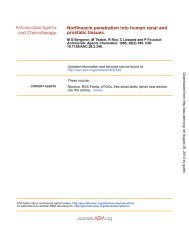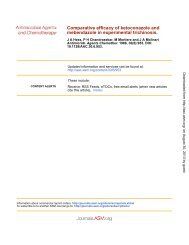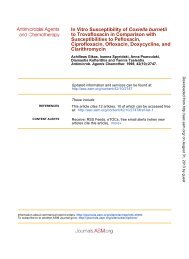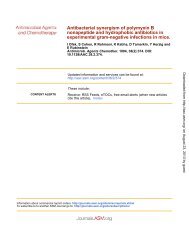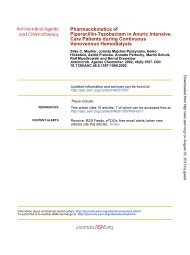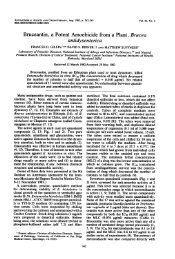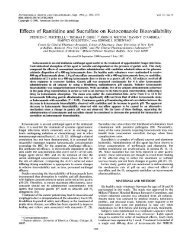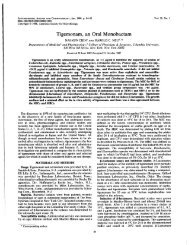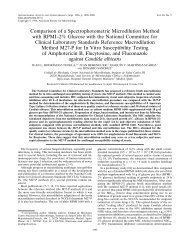In Vitro Cytotoxicity and Antibiotic Activity of Polymyxin B Nonapeptide
In Vitro Cytotoxicity and Antibiotic Activity of Polymyxin B Nonapeptide
In Vitro Cytotoxicity and Antibiotic Activity of Polymyxin B Nonapeptide
You also want an ePaper? Increase the reach of your titles
YUMPU automatically turns print PDFs into web optimized ePapers that Google loves.
<strong>In</strong> vitro cytotoxicity <strong>and</strong> antibiotic activity <strong>of</strong><br />
polymyxin B nonapeptide.<br />
A K Duwe, C A Rupar, G B Horsman <strong>and</strong> S I Vas<br />
Antimicrob. Agents Chemother. 1986, 30(2):340. DOI:<br />
10.1128/AAC.30.2.340.<br />
CONTENT ALERTS<br />
Updated information <strong>and</strong> services can be found at:<br />
http://aac.asm.org/content/30/2/340<br />
These include:<br />
Receive: RSS Feeds, eTOCs, free email alerts (when new articles<br />
cite this article), more»<br />
Downloaded from http://aac.asm.org/<br />
on August 22, 2013 by guest<br />
<strong>In</strong>formation about commercial reprint orders: http://journals.asm.org/site/misc/reprints.xhtml<br />
To subscribe to to another ASM Journal go to: http://journals.asm.org/site/subscriptions/
ANTIMICROBIAL AGENTS AND CHEMOTHERAPY, Aug. 1986, p. 340-341<br />
0066-4804/86/080340-02$02.00/0<br />
Copyright X 1986, American Society for Microbiology<br />
Vol. 30, No. 2<br />
<strong>In</strong> <strong>Vitro</strong> <strong>Cytotoxicity</strong> <strong>and</strong> <strong>Antibiotic</strong> <strong>Activity</strong> <strong>of</strong><br />
<strong>Polymyxin</strong> B <strong>Nonapeptide</strong><br />
AXEL K. DUWE', C. ANTHONY RUPAR,2* GREG B. HORSMAN,1 AND STEPHEN I. VAS'<br />
Department <strong>of</strong> Microbiology, Toronto Western Hospital <strong>and</strong> University <strong>of</strong> Toronto, Toronto, Ontario MST 2S8,1 <strong>and</strong><br />
Department <strong>of</strong> Biochemistry, Children's Psychiatric Research <strong>In</strong>stitute <strong>and</strong> University <strong>of</strong> Western Ontario, London,<br />
Ontario N6A 4G6,2 Canada<br />
Received 27 November 1985/Accepted 15 May 1986<br />
<strong>Polymyxin</strong> B nonapeptide, prepared by enzymic removal <strong>of</strong> the fatty acyl diaminobutyric acid side chain<br />
from polymyxin B, was about 100-fold less toxic to K562 cells than polymyxin B. MICs <strong>of</strong> polymyxin B<br />
nonapeptide against a test panel <strong>of</strong> bacteria were 2- to 64-fold lower than those <strong>of</strong> polymyxin B.<br />
<strong>Polymyxin</strong> B is a peptide antibiotic containing a heptapeptide<br />
ring <strong>and</strong> a fatty acylated tripeptide side chain. It is a<br />
broad-spectrum antibiotic with greater activity against gramnegative<br />
than gram-positive bacteria (4). The antibacterial<br />
activity <strong>of</strong> polymyxin B results from its ability to bind <strong>and</strong><br />
disorganize the outer membrane <strong>of</strong> gram-negative bacteria,<br />
resulting in changes to the membrane permeability barrier<br />
(4). Immobilized polymyxin B can disrupt the Escherichia<br />
coli outer membrane permeability barrier, indicating that<br />
penetration <strong>of</strong> the outer membrane is not required for<br />
activity (3). The inhibition <strong>of</strong> polymyxin B binding to outer<br />
membranes by divalent cations <strong>and</strong> the polycationic nature<br />
<strong>of</strong> polymyxin B suggest that antibiotic-outer membrane<br />
interactions are electrostatic (4).<br />
<strong>Polymyxin</strong> B nonapeptide (PMBN), a derivative <strong>of</strong><br />
polymyxin B which lacks the side chain terminal fatty acyl<br />
diaminobutyrate, binds with relatively high affinity to the<br />
outer membrane (6), disrupts the outer membrane (5), <strong>and</strong><br />
sensitizes gram-negative bacteria to several hydrophobic<br />
antibiotics (8) <strong>and</strong> serum complement (7).<br />
Alterations in the fatty acyl side chain <strong>of</strong> the related<br />
antibiotic, colistin, influence both antimicrobial activity <strong>and</strong><br />
acute toxicity toward mice (1). <strong>In</strong> the present study, the<br />
eucaryotic cytotoxicity against K562 cells <strong>and</strong> antimicrobial<br />
activities <strong>of</strong> polymyxin B <strong>and</strong> PMBN against a panel <strong>of</strong><br />
gram-positive <strong>and</strong> gram-negative bacteria were compared.<br />
The procedure for the preparation <strong>of</strong> PMBN from<br />
polymyxin B sulfate (Sigma Chemical Co., St. Louis, Mo.)<br />
with ficin (Sigma) was similar to procedures previously<br />
described for the degradation <strong>of</strong> colistin (2), with the following<br />
modification. The aqueous phase remaining after butanol<br />
extractions to remove N-acyl diaminobutyric acid <strong>and</strong> undegraded<br />
polymyxin B was concentrated <strong>and</strong> dialyzed with a<br />
UM-2 membrane (Amicon, Oakville, Ontario, Canada). The<br />
purity <strong>of</strong> the PMBN was checked by thin-layer chromatography<br />
on cellulose plates (Merck, Toronto, Ontario, Canada)<br />
with solvent butanol, pyridine, acetic acid, <strong>and</strong> water<br />
(15:10:3:12). The amount <strong>of</strong> polymyxin B contaminant in<br />
PMBN preparations was determined to be
VOL. 30, 1986<br />
TABLE 2. MICs <strong>of</strong> polymyxin B <strong>and</strong> PMBN against<br />
gram-negative <strong>and</strong> gram-positive bacteria<br />
MIC (,ug/ml)<br />
MIC ratio<br />
Strain <strong>Polymyxin</strong> B PMBN (polymyxin B/PMBN)<br />
S. aureus<br />
ATCC 25923 32 128 1/4<br />
ATCC 29213 16 64 1/4<br />
S. epidermidis<br />
ATCC 27626 64 128 1/2<br />
ATCC 14990 16 128 1/8<br />
E. coli ATCC 0.5 32 1/64<br />
25922<br />
K. pneumoniae 2 128 1/64<br />
ATCC 13883<br />
S. marcescens 64 >128<br />
ATCC 13880<br />
P. aeruginosa 0.125 4 1/32<br />
ATCC 27853<br />
4 ml <strong>of</strong> Trypticase soy broth (BBL) <strong>and</strong> incubated for 3 h at<br />
37°C. This was adjusted to a McFarl<strong>and</strong> st<strong>and</strong>ard (0.5) giving<br />
approximately 108 CFU/ml <strong>and</strong> further diluted in sterile<br />
distilled water with 0.02% Tween 80 to 107 CFU. Using a<br />
Dynatech 96-prong semiautomated inoculator, 0.0015 ml<br />
was inoculated into each well containing 0.1 ml <strong>of</strong> Mueller-<br />
Hinton broth. This gave a final concentration <strong>of</strong> 105 CFU/ml.<br />
The plates were incubated at 35°C for 18 h. Each test was<br />
done in triplicate, <strong>and</strong> the endpoint was taken as the lowest<br />
antibiotic concentration at which there was no visible<br />
growth.<br />
PMBN was a less effective antibiotic than polymyxin B<br />
(Table 2). The MICs <strong>of</strong> PMBN were 2- to 8-fold higher for<br />
gram-positive bacteria <strong>and</strong> 32- to 64-fold higher for the<br />
susceptible gram-negative bacteria tested. S. marcescens<br />
was resistant to polymyxin B <strong>and</strong> was not affected by a<br />
tw<strong>of</strong>old higher concentration <strong>of</strong> PMBN. A test tube assay for<br />
MIC <strong>and</strong> MBC in which E. coli ATCC 25922 was grown in 2<br />
ml <strong>of</strong> broth for 2 h was within one tube dilution <strong>of</strong> the<br />
microtiter plate data, <strong>and</strong> the MBCs were >25 ,ug/ml for both<br />
PMBN <strong>and</strong> polymyxin B.<br />
NOTES 341<br />
The toxicity <strong>of</strong> PMBN toward K562 cells was nearly<br />
100-fold less than that <strong>of</strong> polymyxin B, whereas the antibiotic<br />
activity was decreased only 2- to 64-fold against a panel<br />
<strong>of</strong> both gram-negative <strong>and</strong> gram-positive bacteria. The results<br />
suggest that the removal <strong>of</strong> the fatty acyl diaminobutyric<br />
acid side chain terminal from polymyxin B had a<br />
greater effect on eucaryotic cytotoxicity than on antimicrobial<br />
activity. It may therefore be useful to screen the<br />
nonapeptides <strong>of</strong> other polymyxins for both antibiotic activity<br />
<strong>and</strong> eucaryotic toxicity to determine whether some <strong>of</strong> these<br />
nonapeptides may be useful against bacteria resistant to<br />
more conventional antibiotics. Although PMBN was less<br />
toxic to eucaryotic cells in vitro, caution should be exercised<br />
in extrapolating these results to in vivo toxicity. Further<br />
experiments are required to determine how PMBN is metabolized<br />
in vivo. Our results indicate that in vivo studies are<br />
appropriate <strong>and</strong> suggest a useful methodology for a preliminary<br />
screening <strong>of</strong> polymyxin peptides.<br />
LITERATURE CITED<br />
1. Chihara, S., A. Ito, M. Yahata, T. Tobita, <strong>and</strong> Y. Koyama. 1974.<br />
Chemical synthesis, isolation <strong>and</strong> characterization <strong>of</strong> a-Nfattyacyl<br />
colistin nonapeptide with special reference to the correlation<br />
between antimicrobial activity <strong>and</strong> carbon number <strong>of</strong><br />
fattyacyl moiety. Agric. Biol. Chem. 38:521-529.<br />
2. Chihara, S., T. Tobita, M. Yahata, A. Ito, <strong>and</strong> Y. Koyama. 1973.<br />
Enzymatic degradation <strong>of</strong> colistin: isolation <strong>and</strong> identification <strong>of</strong><br />
a-N-acyl a,-y-diaminobutyric acid <strong>and</strong> colistin nonapeptide.<br />
Agric. Biol. Chem. 37:2455-2463.<br />
3. Rosenthal, K. S., <strong>and</strong> D. R. Storm. 1977. Disruption <strong>of</strong> the<br />
Escherichia coli outer membrane permeability barrier by immobilized<br />
polymyxin B. J. Antibiot. 30:1087-1092.<br />
4. Storm, D. R., K. S. Rosenthal, <strong>and</strong> P. E. Swanson. 1977.<br />
<strong>Polymyxin</strong> <strong>and</strong> related peptide antibiotics. Annu. Rev. Biochem.<br />
46:723-763.<br />
5. Vaara, M., <strong>and</strong> T. Vaara. 1983. Polycations as outer membranedisorganizing<br />
agents. Antimicrob. Agents Chemother. 24:<br />
114-122.<br />
6. Vaara, M., <strong>and</strong> P. ViUanen. 1985. Binding <strong>of</strong> polymyxin B<br />
nonapeptide to gram-negative bacteria. Antimicrob. Agents Chemother.<br />
27:548-554.<br />
7. Vaara, M., P. ViUanen, T. Vaara, <strong>and</strong> P. H. Makela. 1984. An<br />
outer membrane-disorganizing peptide PMBN sensitizes E. coli<br />
strains to serum bactericidal action. J. Immunol. 132:2582-2589.<br />
8. ViUanen, P., <strong>and</strong> M. Vaara. 1984. Susceptibility <strong>of</strong> gram-negative<br />
bacteria to polymyxin B nonapeptide. Antimicrob. Agents Chemother.<br />
25:701-705.<br />
Downloaded from http://aac.asm.org/ on August 22, 2013 by guest




